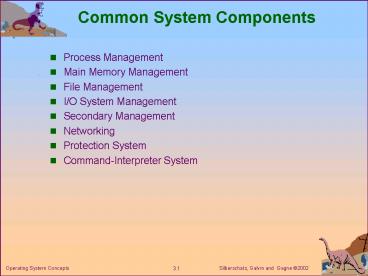Common System Components - PowerPoint PPT Presentation
1 / 10
Title:
Common System Components
Description:
... memory space as needed. Silberschatz, Galvin and Gagne. 2002 3.4 ... File backup on stable (nonvolatile) storage media. Silberschatz, Galvin and Gagne ... – PowerPoint PPT presentation
Number of Views:17
Avg rating:3.0/5.0
Title: Common System Components
1
Common System Components
- Process Management
- Main Memory Management
- File Management
- I/O System Management
- Secondary Management
- Networking
- Protection System
- Command-Interpreter System
2
Process Management
- A process is a program in execution. A process
needs certain resources, including CPU time,
memory, files, and I/O devices, to accomplish its
task. - The operating system is responsible for the
following activities in connection with process
management. - Process creation and deletion.
- process suspension and resumption.
- Provision of mechanisms for
- process synchronization
- process communication
3
Main-Memory Management
- Memory is a large array of words or bytes, each
with its own address. It is a repository of
quickly accessible data shared by the CPU and I/O
devices. - Main memory is a volatile storage device. It
loses its contents in the case of system failure. - The operating system is responsible for the
following activities in connections with memory
management - Keep track of which parts of memory are currently
being used and by whom. - Decide which processes to load when memory space
becomes available. - Allocate and deallocate memory space as needed.
4
File Management
- A file is a collection of related information
defined by its creator. Commonly, files
represent programs (both source and object forms)
and data. - The operating system is responsible for the
following activities in connections with file
management - File creation and deletion.
- Directory creation and deletion.
- Support of primitives for manipulating files and
directories. - Mapping files onto secondary storage.
- File backup on stable (nonvolatile) storage media.
5
I/O System Management
- The I/O system consists of
- A buffer-caching system
- A general device-driver interface
- Drivers for specific hardware devices
6
Secondary-Storage Management
- Since main memory (primary storage) is volatile
and too small to accommodate all data and
programs permanently, the computer system must
provide secondary storage to back up main memory. - Most modern computer systems use disks as the
principle on-line storage medium, for both
programs and data. - The operating system is responsible for the
following activities in connection with disk
management - Free space management
- Storage allocation
- Disk scheduling
7
Networking (Distributed Systems)
- A distributed system is a collection processors
that do not share memory or a clock. Each
processor has its own local memory. - The processors in the system are connected
through a communication network. - Communication takes place using a protocol.
- A distributed system provides user access to
various system resources. - Access to a shared resource allows
- Computation speed-up
- Increased data availability
- Enhanced reliability
8
Protection System
- Protection refers to a mechanism for controlling
access by programs, processes, or users to both
system and user resources. - The protection mechanism must
- distinguish between authorized and unauthorized
usage. - specify the controls to be imposed.
- provide a means of enforcement.
9
Command-Interpreter System
- Many commands are given to the operating system
by control statements which deal with - process creation and management
- I/O handling
- secondary-storage management
- main-memory management
- file-system access
- protection
- networking
10
Command-Interpreter System (Cont.)
- The program that reads and interprets control
statements is called variously - command-line interpreter
- shell (in UNIX)
- Its function is to get and execute the next
command statement.































